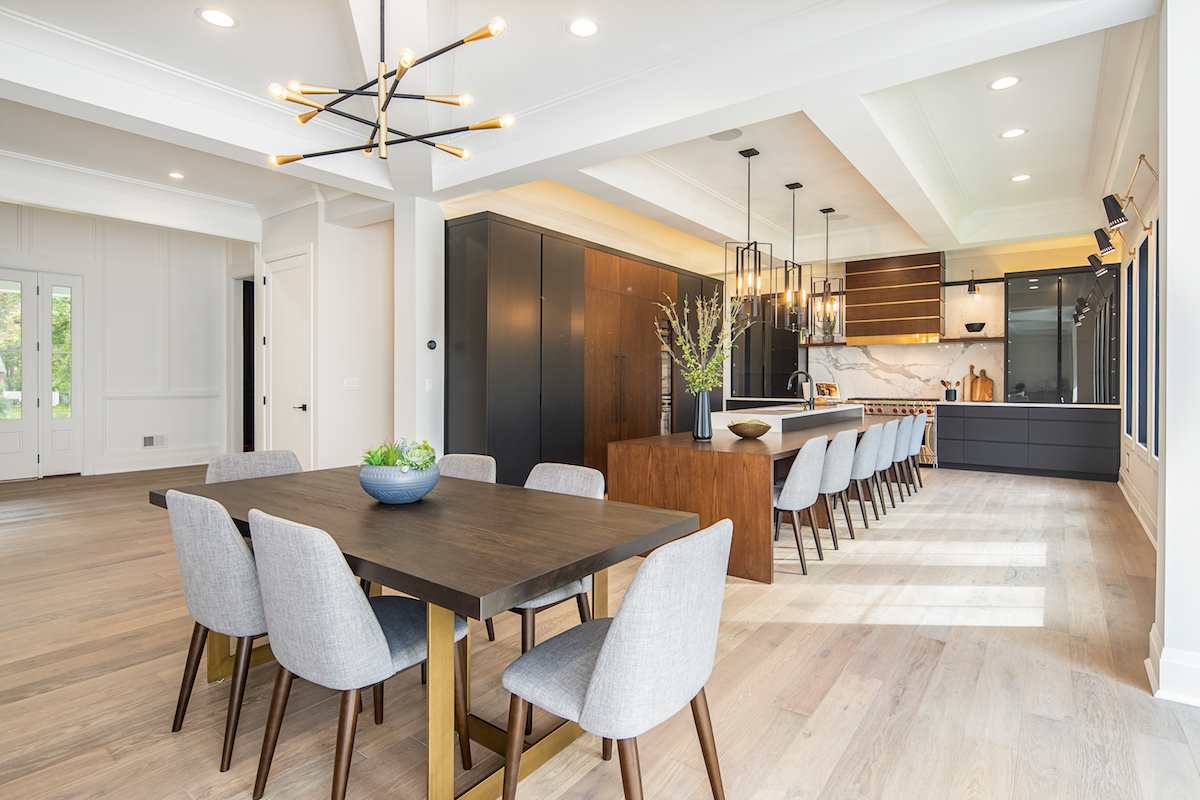
In a neighborhood of gracious, traditional homes, the house with the white exterior—grand as it is—doesn’t stand out or beg for attention. Step inside, though, and it’s an entirely different story. Dramatic sightlines lead from the foyer all the way to the leafy backyard, and from the mudroom, through a spacious open-concept kitchen and great room, to a grand fireplace that extends upward into a two-story pitched ceiling. “I wanted it to be a pleasant surprise when you walk in, with a more contemporary feel on the interior,” says designer Elizabeth Akguc of the Agape Design Group. “My goal was to stand out but still fit in.”
In fact, the house—built on spec in Franklin Lakes by Akguc’s husband, Peter, of Benchmark Builders—is filled with surprises, not the least of which is the extraordinary kitchen, which won a 2020 Gold Design Excellence Award from the New Jersey chapter of the American Society of Interior Designers. If you’re looking for another all-white kitchen, you won’t find it here. The sleek black cabinets are offset by touches of warm wood that appear in a cabinet that hides the Sub-Zero refrigerator, a large rectangular range hood and a set of open shelves flanking the hood, as well as a table in the adjoining breakfast nook.
“The first impression you get from the kitchen,” says Akguc, “is that it’s pretty masculine—tailored, with clean lines. Because the house’s exterior is so bright and full-white, I wanted to give the kitchen contrast and warmth, which is why I brought in natural elements like wood.” The spacious island—it can seat up to six—is a revelation in itself. Its oak dining surface is actually table height, accommodating up to six standard-height chairs below it; it also incorporates a sink and surrounding quartz workspace, raised above the dining area for convenient food prep. “What I find with islands and stools,” says Akguc, “is that you don’t spend that much time on them—they’re very uncomfortable.” Her aim was to create a hub where family and friends would want to linger.
But if the kitchen contains some darker elements, it’s suffused with light, from a trio of large windows on one wall and a wonderfully mixed bag of lighting that includes three geometric open-lantern pendants over the island, a linear “Sputnik”- style chandelier above the kitchen table and modern black-and-brass sconces between the windows and above the open shelves.
The kitchen isn’t the home’s only surprise. Bucking the trend of the full open concept, the dining room, just off the foyer, is entirely separate. As cozy and cosseting as it is distinctive, it features black wainscotted walls, balanced by light wood floors and a white coffered ceiling. The black-and-white theme continues in an adjacent butler’s pantry. (At the home’s closing, the buyers thanked Akguc for not giving them a white kitchen and for creating a dining room that was anything but boring.)
Even the home’s open-concept spaces—the kitchen, dining nook and great room—maintain a sense of separation, thanks to different patterns of coffering on the ceilings above each area. Nevertheless, there’s a remarkable cohesiveness to the home’s overall design. The flooring is white oak throughout, and black and gold accents pop up everywhere, from the windows with black painted frames and mullions and the black-and-white tile in the butler’s pantry to touches of gold in the powder room wallpaper to an extravagantly gilded dining room chandelier.
But as dramatic as it is, the house is also eminently practical. There’s that table-height island, of course, and the kitchen’s double pantries, a bar in the master bedroom and, brilliantly, two powder rooms on the main floor—one off the mudroom and the other closer to the great room. As the mother of two young children, Akguc knew that family members, not to mention guests, are loath to traipse upstairs to use the bathroom. Each of the two rooms has a very different mood.
One is bright and classic, with navy walls and gold-toned fixtures. The other is more intense, with a black marble floating sink-and-counter and soft gold wallpaper.
Perhaps the house’s most dramatic space is the great room, with its floor-to-ceiling fireplace surround and a pair of white-oak beams that form an inverted V adjacent, on both sides, to a set of clerestory windows. “It is a two-story room,” says the designer, “but because of the pitched roof it feels warmer and more inviting.” That roofline could also make it feel smaller than the typical great room, except that both the fireplace surround and the beams draw the eye upward, and an abundance of windows flood the space with natural light.
Like the rest of the house, the great room feels open and contemporary but also timeless, its modern elements balanced by more traditional details such as the rectangular windows (no glass walls here) and the white marble that frames the fireplace beneath the soaring surround. In fact, “timeless” is the word Akguc uses to sum up her overall design. It could easily be updated over the years with small changes, she notes, “but there’s nothing in it that’s trendy. I designed it to last a lifetime and more.”